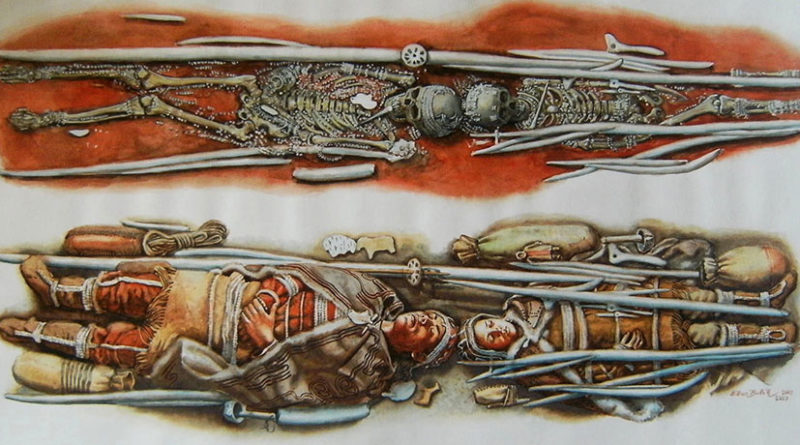GENETICS, ANTHROPOLOGY, HUMAN EVOLUTION: Ancient humans avoided inbreeding by networking
DNA from 34,000 years ago suggests hunter-gatherers left home to find mates
DNA of people who lived around 34,000 years ago reveals an especially lively social scene that may have been a key to humans’ evolutionary success.
Much like hunter-gatherers today, ancient Eurasians married outside their home groups and formed webs of friends and in-laws vital for eventually building cities and civilizations, a new study suggests.
Long-gone hunter-gatherers lived in groups with few close relatives, thus limiting opportunities for inbreeding, say evolutionary geneticist Martin Sikora of the Natural History Museum of Denmark in Copenhagen and his colleagues. It’s likely that adolescents of both sexes found mates in communities other than their own, fostering social ties among groups that might otherwise avoid or fight each other, the scientists conclude online October 5 in Science. Modern hunter-gatherers likewise find partners among nearby groups (SN: 4/9/11, p. 13).
Sikora’s findings support a proposal that hunter-gatherer bands composed mainly of in-laws and unrelated individuals appeared by the late Stone Age and probably much earlier than that, says anthropologist Kim Hill of Arizona State University in Tempe, who did not participate in the new study. The emergence of in-laws boosted communication and social learning across groups, a prerequisite for creating civilizations.
“Hunter-gatherer social structure is apparently unique to humans and is the reason why we alone are so reliant on culture and have achieved the marvels of technology and human society,” Hill says.
The new study undercuts a long-standing idea that Stone Age hunter-gatherers clustered among close kin, with men forming alliances and guarding home territories against competing groups, much as chimpanzees now do. If that’s true, then the spread of agriculture around 10,000 years ago may have been what led modern hunter-gatherers to develop extensive social networks. But Sikora’s study “shows that modern humans already lived in socially fluid societies well before the origins of agriculture,” says anthropologist Andrea Migliano of University College London.
Living in small, interacting groups consisting mainly of those who weren’t kin made sense for people roaming near-arctic parts of Europe and West Asia starting around 40,000 years ago, says paleoanthropologist and study coauthor Marta Mirazón Lahr of the University of Cambridge. Those hunter-gatherers had to forage over large areas to survive, and mate exchanges among groups minimized inbreeding, she contends.
Skeletons of four people buried at a Russian site called Sunghir provided DNA for the new analysis. These individuals include a man in his own grave and two preteens or early adolescents placed head-to-head in the same grave, near a piece of an adult’s upper leg bone filled with a red pigment. Both graves included fancy items such as ivory beads and spears, armbands and carvings. Researchers have excavated Sunghir intermittently since the 1950s.
New radiocarbon dates for the human fossils and a mammoth bone found at the site provided a more precise date for the Sunghir burials than was previously available.
Ancient DNA from the four Sunghir individuals includes parts of the sex chromosomes, indicating that all of them were male. Scientists had previously suspected that one of the Sunghir youngsters was a girl. Genetic comparisons found no signs of close biological kinship. No parent, grandparent, sibling, aunt, uncle, niece or nephew relationships turned up.
An analysis of a largely complete set of genetic instructions from one Sunghir youngster suggested that he came from a population that split off around 38,000 years ago from direct ancestors of modern Europeans. That ancient Sunghir-related population was relatively small, with anywhere from about 160 to 900 procreating adults, the researchers estimate.
In rough agreement with previous estimates for present-day Europeans and East Asians, Sunghir individuals inherited about 2.5 percent of their DNA from Neandertals, Sikora’s team finds. That interbreeding occurred around 55,000 years ago, the investigators calculate.
Further cross-species flings around 36,000 years ago contributed nearly another 0.4 percent Neandertal DNA to the Sunghir group, they say.
Sunghir people did not display genetic markers of inbreeding previously observed in Neandertal DNA (SN: 1/25/14, p. 17). Neandertals lacked mating networks like those of ancient humans, the researchers propose.
M. Sikora et al. Ancient genomes show social and reproductive behavior of early Upper Paleolithic foragers. Science. Published online October 5, 2017. doi:10.1126/science.aao1807.
.
B. Bower. Neandertal genes point to interbreeding, inbreeding. Science News. Vol. 185, January 25, 2014, p. 17.
B. Bower. In-laws transformed early human society. Science News. Vol. 179, April 9, 2011, p. 13.
Courtesy: Science News Org.|
<>
Aseanews.Net | [email protected] | Contributor









